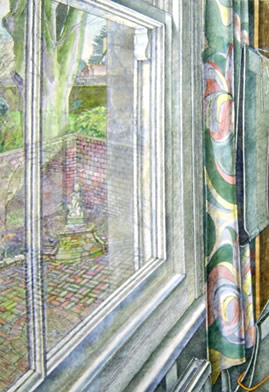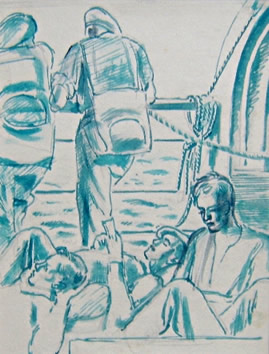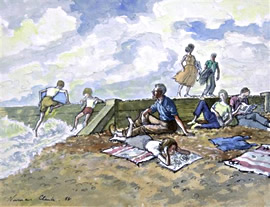
Photograph reproduced
by kind permission
of the artist's daughter.


|
Norman Clark was born in 1913 and was educated at Bancroft's School in Essex. He attended Central School of Arts from 1929-30 where amongst his teachers were Bernard Meninsky and William Roberts, both of whose work went on to have a strong influence on Clark's style as a painter. He went on to the Royal Academy Schools in the following year, where he excelled, winning the Royal Academy Gold Medal in Painting, together with the Edward Stott Scholarship and the Landseer Prize for mural decoration. He was also a Leverhulme scholar.
During his military service in the Second World War, Norman Clark used quieter moments to make sketches, transforming many of these drawings into watercolour paintings after his demobilisation. Most of these depict the part of rural Italy where he was posted together with the everyday life of the wartime soldier.
In 1947 he moved to Hurstpierpoint in Sussex, remaining there until his death in 1992 and teaching at Brighton College of Art for much of his working life. It was the village of Hurstpierpoint, its characters and the beautiful views across the nearby South Downs that provide the primary inspiration for much of his work. He always had an eye for the unconventional when depicting his subject, whether a landscape, event, or of a local character or personality. Indeed whilst exceptional attention to unusual detail dominates much of his landscape and still life painting, the human figure was the central focus of his artistic imagination. Writing about his own work in October 1989:

"Much of my work has been concerned with the human figure. Whenever … I draw from memory it is always a human being that appears. Characters from the past seem to pose from me in my mind, some of them being deceased relatives, some never seen before."
Clark exhibited widely at the Royal Academy, the Royal Watercolour Society and locally at the the Society of Sussex Painters and the Sussex Watercolour Society. He was elected an Associate of the Royal Watercolour Society in 1953, becoming a full member in 1960.
|